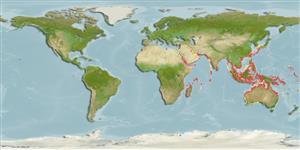Common names from other countries
>
Acanthuriformes (Surgeonfishes) >
Ephippidae (Spadefishes, batfishes and scats)
Etymology: Ephippus: Greek, ephippion, horse cloth, saddle.
More on author: Bloch.
Environment: milieu / climate zone / depth range / distribution range
Écologie
marin récifal; amphidrome (Ref. 51243); profondeur 10 - 30 m (Ref. 9710). Tropical
Indo-West Pacific: Persian Gulf to Natal, South Africa, eastward to India and Lesser Sunda Island, Indonesia, north to Japan (Ref. 559) and Taiwan, south to northern Australia (Ref. 9710).
Taille / Poids / Âge
Maturity: Lm ? range ? - ? cm
Max length : 25.0 cm TL mâle / non sexé; (Ref. 559)
Épines dorsales (Total) : 9; Rayons mous dorsaux (Total) : 19 - 20; Épines anales: 3; Rayons mous anaux: 15 - 17. Head and body silvery blue-green. Four or 5 faint dark blue bars often visible on body. Fins dusky. Body orbicular and strongly compressed, its depth more than twice length of head. Eye above horizontal axis through mouth. Mouth small, the maxilla not reaching past vertical at front edge of eye. Jaws with bands of slender, incisiform teeth with a single lanceolate cusp. No teeth on palatines or vomer. Preopercle distinctly serrate, with a broad naked margin. Opercle without spines (Ref 43039).
Inhabits shallow water, over mud bottoms. Feeds on benthic invertebrates and fishes (Ref. 9616).
Life cycle and mating behavior
Maturities | Reproduction | Spawnings | Egg(s) | Fecundities | Larves
Kuronuma, K. and Y. Abe, 1986. Fishes of the Arabian Gulf. Kuwait Institute for Scientific Research, State of Kuwait, 356 p. (Ref. 5999)
Statut dans la liste rouge de l'IUCN (Ref. 130435)
CITES (Ref. 128078)
Not Evaluated
Menace pour l'homme
Harmless
Utilisations par l'homme
Pêcheries: commercial
Outils
Articles particuliers
Télécharger en XML
Sources Internet
Estimates based on models
Preferred temperature (Ref.
115969): 24.7 - 29.2, mean 28.3 (based on 690 cells).
Phylogenetic diversity index (Ref.
82804): PD
50 = 0.7500 [Uniqueness, from 0.5 = low to 2.0 = high].
Bayesian length-weight: a=0.02692 (0.01137 - 0.06373), b=2.94 (2.74 - 3.14), in cm Total Length, based on LWR estimates for this (Sub)family-body shape (Ref.
93245).
Niveau trophique (Ref.
69278): 4.0 ±0.61 se; based on food items.
Résilience (Ref.
120179): Milieu, temps minimum de doublement de population : 1,4 à 4,4 années (Preliminary K or Fecundity.).
Fishing Vulnerability (Ref.
59153): Low vulnerability (15 of 100).
